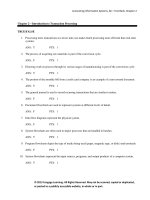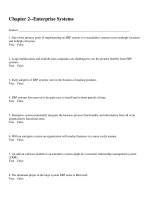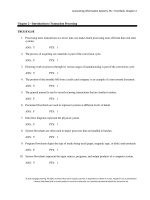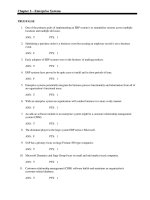Accounting information systems ch11
Bạn đang xem bản rút gọn của tài liệu. Xem và tải ngay bản đầy đủ của tài liệu tại đây (3.27 MB, 36 trang )
Chapter 1
The
Billing/Accounts
Receivable/Cash
Receipts
(B/AR/CR)
Process
1
Learning Objectives
•
•
•
•
•
•
Understand relationship between B/AR/CR
and its environment
Understand relationship between B/AR/CR
and management problem solving at
various levels of the organization
Become familiar with some of the
technology used in implementing the
B/AR/CR process
Achieve a reasonable level of
understanding of the logical & physical
characteristics of the process
Gain a foundation level of understanding
as to how enterprise systems impact the
processing of information in the B/AR/CR
process
Recognize some plans commonly used to
control the B/AR/CR process
B/AR/CR
Process
B/AR/CR Spoke on AIS Wheel
• In this chapter we
spotlight one business
process, (B/AR/CR)
process.
• We will describe the
various users of the
(B/AR/CR) process, each
having their own view of
the enterprise system and
enterprise database.
• In addition, we will
analyze the process
controls related to the
(B/AR/CR) process.
3
Introduction
•
The billing/accounts receivable/cash receipts
(B/AR/CR) process is an interacting structure of
people, equipment, methods, and controls designed
to create information flows and records that
accomplish the following:
1. Support the repetitive work routines of the credit
department, the cashier, and the accounts receivable
department
2. Support the problem-solving processes of financial
managers
3. Assist in the preparation of internal and external reports
4
Horizontal View B/AR/CR
1. Shipping
department
informs the
accounts
receivable
department
(billing
section) of
shipment.
5
Horizontal View B/AR/CR
2. Accounts
receivable
department
(billing) sends
invoice to
customer.
6
Horizontal View B/AR/CR
3. Accounts
receivable
department
(billing)
informs
general ledger
process that
invoice was
sent to
customer.
7
Horizontal View B/AR/CR
4. Customer,
by defaulting
on amount
due, informs
credit
department of
nonpayment.
8
Horizontal View B/AR/CR
5. Credit
department
recommends
write-off of
the receivable
and informs
accounts
receivable
department.
9
Horizontal View B/AR/CR
6. Credit
department,
by changing
credit limits,
informs sales
order
department to
terminate
credit sales to
customer.
10
Horizontal View B/AR/CR
7. Accounts
receivable
department
informs
general ledger
process of
write-off.
11
Horizontal View B/AR/CR
8. Customer
makes
payment on
account.
12
Horizontal View B/AR/CR
9. Cashier
informs
accounts
receivable
department
(cash
applications
section) of
payment.
13
Horizontal View B/AR/CR
10. Cashier
informs
general ledger
process of
payment.
14
CSS: Customer Self-Service Systems
• CSS is an extension of CRM that allows a customer to
complete an inquiry or perform a task without the aid
of the organization’s employees
– ATMs, Speedpass, Automated telephone systems
• A major extension: interconnection of CSS systems
with enterprise systems
– In some cases, customers can check their orders during the
manufacturing process or check inventory before placing orders.
– Some of the more advanced systems also allow customers to check
production planning for future manufacturing to determine if goods will
be available when they are needed.
• Why are companies so interested in customer selfservice systems?
– The payback on such systems is huge
– Reduction of staffing needs for call centers is particularly beneficial
15
Digital Imaging Processing Systems
• Because of the quantity of paper documents
that typically flow through the B/AR/CR
process, the ability to quickly scan, store,
add information to, and retrieve documents
can significantly reduce:
– labor costs for filing
– costs of physical storage space and structures
necessary for storing paper-based files.
16
Cash Receipts Management
• In the billing function, the goal is to get invoices to
customers as quickly as possible; with the hope of
reducing the time it then takes to obtain customer
payments.
• Having the B/AR/CR process produce invoices
automatically helps ensure that invoices are sent to
customers shortly after the goods have been shipped.
• Float, when applied to cash receipts, is the time between
the customer tendering payment and the availability of
good funds.
• Good funds are funds on deposit and available for use.
17
Cash Receipts Management
• The following procedures are designed to reduce or
eliminate the float associated with cash receipts:
– Checks
• High-speed electronic equipment is able to read the magnetic ink
character recognition MICR code and sort checks at speeds
approaching 100,000 checks per hour
– A charge card or credit card
• A third party, for a fee, removes from the collector the risk of
noncollection of the account receivable.
• The retailer submits the charges to the credit card company for
reimbursement.
• The credit card company bills the consumer
– A debit card
• Authorizes the collector to transfer funds electronically from the
payer’s to the collector’s balance.
• Some retailers find the notion of direct debit attractive because it
represents the elimination of float.
18









